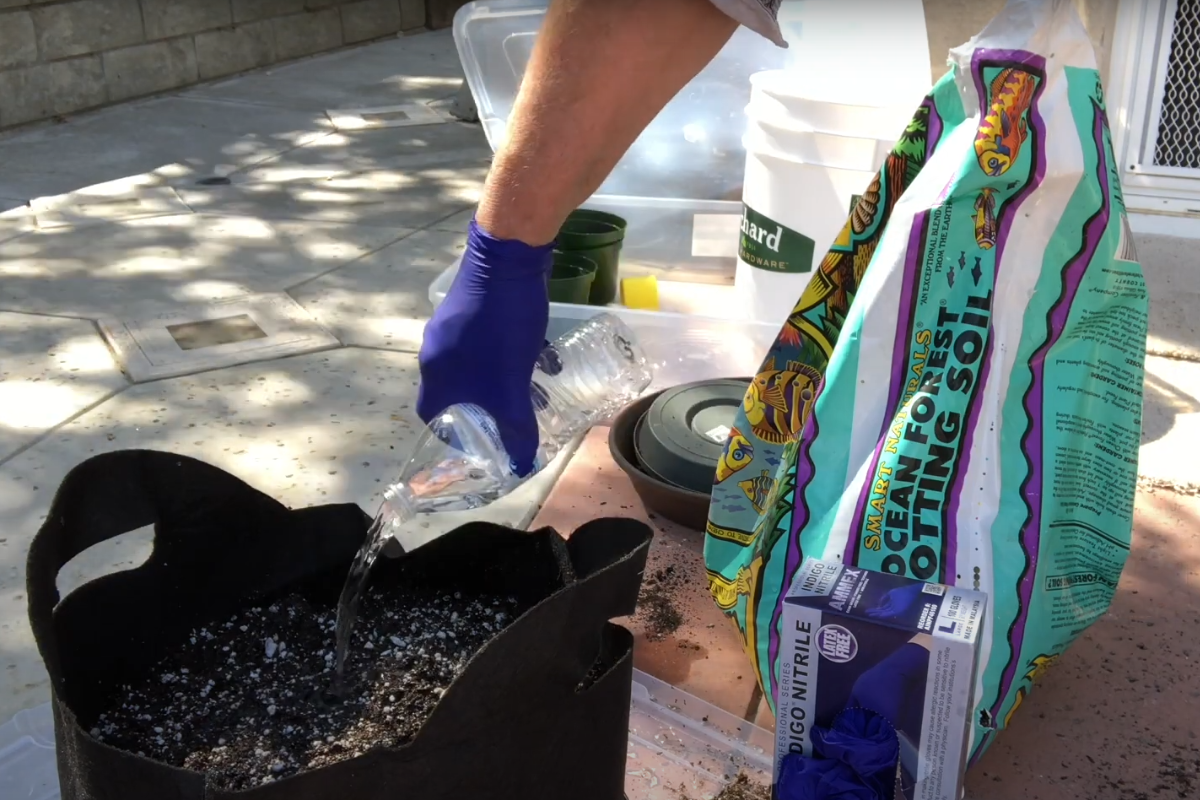I've spent years perfecting my indoor grow setup, and nothing beats the satisfaction of harvesting potent buds from my own 5-gallon autoflower plants. But believe me, I learned the hard way when it comes to watering.
Too much or too little, and your plants will show their displeasure. This is why getting the how much water for 5-gallon autoflower question right is so critical for a successful harvest.
Why Mastering How Much Water for 5 Gallon Autoflower is Key

Autoflowers are unique because they flower based on age, not changes in light cycles. That makes them great for both newbie growers and seasoned veterans. However, this doesn't make them invincible to watering issues. Watering is more than just quenching thirst; it's how your autoflower plants eat.
Water dissolves nutrients in the soil, making them accessible to the plant's roots. Proper watering, using techniques like the bottom-up method, ensures these vital nutrients are delivered throughout the plant, impacting everything from stem strength to resinous buds.
The Perils of Overwatering
Have you ever walked past a houseplant and smelled something funky? That's often root rot, a common sign of overwatering. Soggy soil squeezes out air pockets, literally suffocating the roots. Without these air pockets, roots can't absorb nutrients, leading to nutrient deficiencies, stunted growth, and even plant death.
Telltale Signs of Overwatering:
Drooping leaves, even when the soil is wet.
Yellowing leaves, starting from the bottom.
A foul, musty odor coming from the soil.
Stunted or slow growth compared to other plants.
The Dangers of Underwatering

While not as immediately damaging as overwatering, underwatering stresses your autoflowers, making them more susceptible to pests and diseases. Inadequate water means nutrient transport slows down, leading to slow growth, smaller yields, and less potent buds – not the outcome any grower wants.
Key Indicators of Underwatering:
Dry and crumbly soil that pulls away from the edges of the pot.
Wilting leaves that feel dry to the touch.
Slowed or stunted growth.
Leaf tips turning brown and crispy.
Finding Your How Much Water for 5 Gallon Autoflower Sweet Spot
The million-dollar question for growing in 5-gallon containers: how much water does an autoflower actually need? Here’s where observation becomes your superpower. Consider the climate of your grow room and adjust your watering schedule accordingly. For example, if your grow room tends to be more humid, your plants may require less frequent watering.
Factors Impacting Water Requirements:

While I'd love to give a magic number, a one-size-fits-all approach to how much water for a 5-gallon autoflower doesn't exist. Several factors come into play, so pay attention to these:
1. Environmental Conditions:
High temperatures and low humidity mean more frequent watering. During hotter months, my 5-gallon autoflowers need water every day, sometimes even twice. When the weather cools down, I might only water every other day.
The amount of light your plants receive also plays a significant role in their water requirements. Plants that receive more light will photosynthesize more, leading to increased water uptake and transpiration. In contrast, plants in lower light conditions will require less water. Airflow is another environmental factor to consider. Good air circulation around your plants will help excess moisture evaporate from the soil and leaves, reducing the risk of overwatering and associated issues like mold and root rot. Regularly monitoring temperature, humidity, light intensity, and airflow will help you adjust your watering schedule accordingly.
2. Growth Stage:
Just like teenagers seemingly morph overnight, your autoflowers will have growth spurts demanding more water.
Seedling Stage: During those initial weeks, less is more. Overwatering is a real risk as seedlings are fragile. At this stage, the root system is still developing, and the seedlings don't require much water. Water sparingly, allowing the soil to dry out between waterings to encourage root growth.
Vegetative Stage: As your plants pack on foliage and shoot up, their water needs increase significantly. The vegetative stage is characterized by rapid growth, with plants developing a robust root system and lush foliage. As the root system expands, the plants can uptake more water, necessitating more frequent watering.
Flowering Stage: Brace yourself—this stage requires the most frequent watering. Your plants are putting all their energy into producing buds and will be thirsty. During flowering, plants reach their maximum size and have the highest water requirements. Expect to water more often, but still allow the soil to partially dry out between waterings to avoid overwatering and ensure proper oxygen availability to the roots.
3. Soil Type
Choosing the right soil mix is crucial for moisture retention. A well-draining cannabis soil mix prevents overwatering, even with heavy-handed watering.
Soils rich in organic matter, such as peat moss or coco coir, retain moisture well, while those with more perlite or vermiculite drain quickly and require more frequent watering. The best cannabis soil balances water retention and drainage, providing roots with both moisture and oxygen.
Adjust ingredient ratios based on your environment for optimal results.
Practical Tips for Consistent Watering
Now that you know the variables, let's focus on practical techniques I've found successful. These can make a big difference when you're determining how much water a 5-gallon autoflower needs to give.
The "Lift and Feel" Test
This trick has never let me down. Before watering, lift the pot. If it feels light, it's time to water. If it's still heavy, hold off, even if the top of the soil looks dry.
With practice, you'll develop a keen sense of how heavy a pot should feel when it's time to water. This method is particularly useful for gauging the moisture content in the root zone, where it matters most. Keep in mind that the pot's weight will vary depending on the size of your plant and its stage of growth.
As your autoflower grows larger and the root system expands, the pot will naturally become heavier. Adjust your expectations accordingly and use the weight of the pot in combination with other indicators, like the appearance of the soil surface and the plant itself, to determine when to water.
Investing in a Soil Moisture Meter
A soil moisture meter is a helpful tool, especially for beginners learning how much water their autoflowers in 5-gallon pots need. Simply insert the probe to check moisture levels at various depths and spots in the pot for a full picture of root zone hydration.
Keep in mind that meters may be less accurate in soils with high organic matter or when the probe touches large roots. Use it as a guide alongside your observations to decide when to water.
Observing Your Plants: The Best Indicator
Don’t ignore your plants’ cues—wilting, drooping, or discoloration often signal watering issues. Underwatered plants have soft, limp leaves and drooping stems, while overwatered ones may also wilt but with firm, rigid leaves.
Yellowing leaves can indicate overwatering due to nutrient deficiencies. Regularly inspect your plants for stress signs and adjust watering habits promptly to keep your autoflowers healthy and thriving.
Watering Techniques That Work for Me
Over the years, I've experimented with a bunch of techniques. These two have consistently produced great results for my 5-gallon autoflowers:
1. The Top-Down Approach
The most straightforward technique – I slowly water the soil surface, ensuring the water reaches the entire pot’s circumference. Allow the excess to drain. Remember: You want moist soil, not a swamp.
2. The Bottom-Up (Tray) Method
This technique minimizes runoff and ensures the roots stay hydrated. I simply place the 5-gallon pots in a shallow tray filled with water. The soil wicks up the water, giving the plants time to drink at their own pace. This approach can help address those pesky dry pockets of soil that sometimes happen with the top-down method.
Optimizing Your How Much Water for 5 Gallon Autoflower Game: Pro Tips
Want to graduate from grower to green-thumbed guru? These tips picked up from years of trial and error, can help your autoflowers thrive:
1. pH Your Water
Autoflowers are finicky when it comes to pH. A pH between 6.0 and 6.5 ensures those nutrients in your carefully selected soil actually get absorbed. I always test my water and use a pH adjuster to maintain that ideal range.
2. Use Filtered Water
Chlorine and other additives in tap water can harm plants. Filtered or dechlorinated water minimizes these risks and ensures a healthy root system.
3. Don’t Water on a Schedule
This goes back to being observant. Those factors mentioned earlier—environment, growth stage, soil type— they mean your plants' water needs change throughout the week. Feeling the weight of the pot, looking at the soil's condition, and being attuned to those telltale plant signs will always give you a more accurate answer to how much water for a 5-gallon autoflower. Then, any calendar notification will.
4. Consider Mulch for Water Retention
Remember our earlier chat about dry soil woes? Mulch is the solution. I use a layer of coconut coir or straw on top of the soil. This acts like a protective barrier, holding onto moisture and reducing how often I need to water.
5. Prioritize Drainage
Root rot is a grower's nightmare, often caused by poorly draining soil or containers. Ensure your pots have sufficient drainage holes to prevent water from pooling around the roots. Don’t let excess water sit in the saucers; it’ll create that swampy environment those root-rot fungi love. Remember, air circulation is just as vital as water when you're asking how much water for 5-gallon autoflower?.
Conclusion
Mastering the art of how much water to give a 5-gallon autoflower isn't about rigidly following rules. It's about understanding your plants' needs. Be observant and adaptable with your watering, and your autoflowers will reward you with an abundant bounty.
Q: What are some essential watering tips for plants in 5-gallon pots?
A: It is important to water plants in 5-gallon pots according to their specific needs. Ensure the soil is moist but not waterlogged. Water around the plant to encourage root growth and avoid pooling water on the surface.
Q: How often should I water my plants in 5-gallon pots?
A: The frequency of watering will depend on various factors, such as plant type, environmental conditions, and soil moisture level. In general, it is recommended that plants in 5-gallon pots be watered every 3 days, but always check the soil's moisture level before watering.
Q: Can I use fabric pots for plants in 5-gallon pots?
A: Yes, fabric pots are an excellent choice for plants in 5-gallon pots. They provide good drainage and aeration for the roots, which can help prevent overwatering and promote healthy root development.
Q: How much water should I give to plants in 5-gallon pots?
A: The amount of water needed for plants in 5-gallon pots can vary, but a general guideline is to water until you see some runoff at the bottom of the pot. This ensures that the entire root system receives water.
Q: When is the best time to water plants in 5-gallon pots?
A: It is recommended to water plants in 5-gallon pots early in the morning or late in the evening when the temperatures are cooler. This helps prevent water evaporation and allows the plants to absorb moisture more effectively.
Q: How can I prevent overwatering plants in 5-gallon pots?
A: To prevent overwatering, always check the soil moisture before watering. Make sure the top few inches of the soil are dry before giving more water. Additionally, ensure proper drainage in the pots to avoid waterlogged conditions.
Q: Should I adjust the amount of water during different stages of plant growth in 5-gallon pots?
A: Yes, the water requirements of plants in 5-gallon pots may vary during different stages of growth. For example, seedlings may need less water than mature plants. Adjust the frequency and amount of water based on the plant's growth stage.





